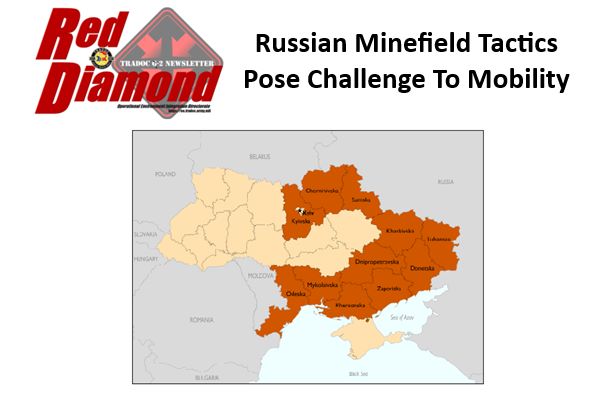
Russian Minefield Tactics Pose Challenge to Mobility
By Richard L. Garcia & Colin Colley
The Russian Army is laying minefields that are significantly larger and, therefore, more challenging to breach than what has been seen in Ukraine since Russia invaded Crimea and the Donbas in 2014.
Since the wider Russian invasion of Ukraine in 2022, Ukraine has surpassed Afghanistan and Syria to become the most heavily mined country on earth.i Landmines have been identified in 11 of Ukraine’s 27 regions—Chernihivska, Dnipropetrovska, Donetska, Kharkivska, Khersonska, Kyivska, Luhanska, Mykolaivska, Odeska, Sumska, and Zaporizka.ii Ukrainian armed forces, separatist groups, and the Russian Army have used landmines extensively as tactical weapons, exploiting their ability to disrupt enemy movements, halt penetrations, and inflict casualties.
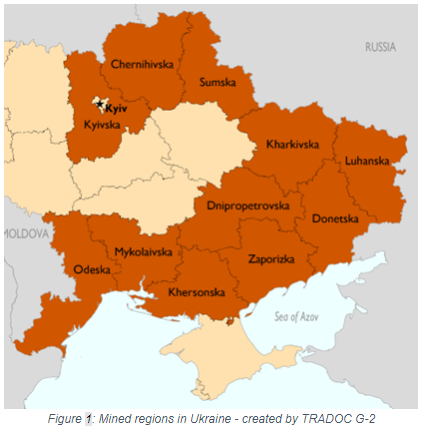
Over the winter of 2022-23, Russian forces increased the amount and depth of their defensive positions—including minefields—while the Ukrainians prepared to go on the offensive. Russian doctrine emphasizes attrition of enemy forces rather than mobility, and landmines are a vital component. Russian forces initially followed their doctrine and created minefields with a width and depth of 100-200 meters.iii However, over time, Russian forces have expanded the size of minefields to 500 meters or more and, in some cases, have increased their density.iv Most of these more extensive minefields are located along the principal axes of advance.
Russia produces antipersonnel and antivehicle mines, including new designs not seen in other conflicts, such as the PTM-4M and POM-3.v Human Rights Watch has discovered at least 13 types of antipersonnel mines and 13 types of antivehicle mines (see Appendices for details on specific mine variants).vi In the Ukraine war, Russia has used only domestically produced mines, resulting in shortages likely due to insufficient manufacturing capacity to keep up with demand. To overcome this challenge, the Russian Army has resorted to creating irregularly shaped minefields, increasing the distance between mines, mixing in fake mines with live AT mines, and creating dummy minefields.vii
Russian mines have created a significant challenge for Ukrainian forces, many of which have limited breaching capabilities. Several NATO countries have donated additional breaching systems to Ukraine.viii Even with these breaching assets, a 500-meter minefield would take approximately 1.5 hours or more to breach. Additionally, most of these minefields are combined with other obstacles like tank ditches and dragon teeth, making the operation even more challenging and time-consuming. The persistent drone surveillance makes Ukrainian breaching elements vulnerable to detection and Russian artillery fire.ix Ukraine’s inability to breach Russian minefields stalled their 2023 counteroffensive. In three months, the Ukrainians only advanced approximately 16 kilometers along their three main axes of advance.x
The Russian Army has learned that with enough mines—or even the threat of significant mines—a Ukrainian assault can be slowed or even halted by defeating their breaching operations. To overcome this challenge, the Ukrainian Army must modify its mine-clearing and breaching solution. For example, a better counter-UAS capability could provide Ukrainian forces more time to breach by disrupting Russian surveillance drones. However, the longer it takes the Ukrainian Army to develop an effective breaching strategy, the more time it gives the Russian Army to improve its defensive positions.
Implications for the U.S. Army
As minefields and other obstacles become more advanced, U.S. Army maneuver units could emphasize training on breaching deep obstacles, targeting enemy engineer assets, and the OPFOR could simulate Russian obstacle tactics.
- Russian operations in Ukraine emphasize attrition of enemy forces rather than mobility. Landmines are one method that forces mobility-focused armies into an attrition fight, suggesting U.S. Army units may benefit from placing greater emphasis on training for breaching deep obstacles under constant observation and heavy indirect fire.
- Preventing large-scale minefield emplacement requires targeting mine-laying equipment and units to disrupt these obstacles before they are placed. In training exercises, targeting engineer assets could reduce the enemy’s minelaying and obstacle construction capability. Reducing enemy engineer assets will support rapid maneuver and lessen the need to breach deep minefields covered by observation and fires.
- OPFOR could adopt tactics similar to Russia’s minelaying and obstacle tactics. Given that mobility is a strength of U.S. ground forces, the OPFOR could create obstacle belts that force the blue force to overcome counter mobility obstacles, including deep minefields supported by persistent drone surveillance and artillery.
Appendix 1: Russian Antipersonnel Landmines Used in Ukraine Since 24 February 2022
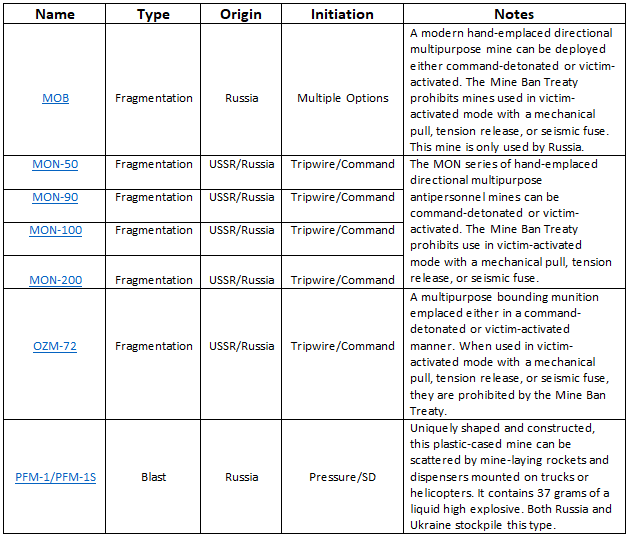

Appendix 2: Russian Antivehicle Landmines Used in Ukraine Since 24 February 2022
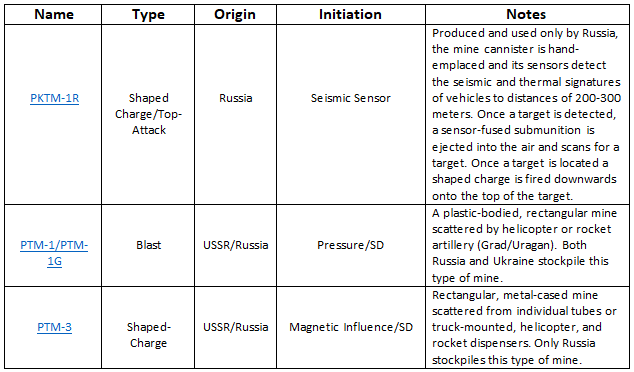
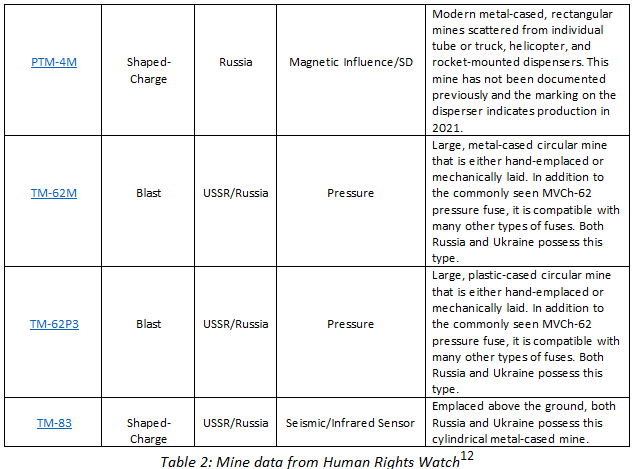
NOTES
1 Human Rights Watch. (2023, June 14). Landmine use in Ukraine – Ukraine. ReliefWeb. https://reliefweb.int/report/ukraine/landmine-use-ukraine
2 Ibid
3 Grau, Lester W. and Charles K. Bartles.. The Russian Way of War: Force structure, tactics, and modernization of the Russian Ground Forces. Fort Leavenworth, KS: Army University Press, 2017. https://www.armyupress.army.mil/portals/7/hot%20spots/documents/russia/2017-07-the-russian-way-of-war-grau-bartles.pdf.
4 Axe, David. “To slow the Ukrainian counteroffensive, the Russian army quadrupled the size of its minefields.” Forbes. September 5, 2023. https://www.forbes.com/sites/davidaxe/2023/09/05/to-slow-the-ukrainian-counteroffensive-the-russian-army-quadrupled-the-size-of-its-minefields/?sh=3f59f52469e.
5 Burgess, Annika. “Landmines, booby traps and tripwires — the hidden threats covering one-third of Ukraine.” ABC News. June 16, 2023. https://www.abc.net.au/news/2023-06-17/ukraine-landmines-booby-traps-trip-wires-demining-mine-clearing/102468924.
6 Human Rights Watch. (2023, June 14). Landmine use in Ukraine – Ukraine. ReliefWeb. https://reliefweb.int/report/ukraine/landmine-use-ukraine
7 Pickrell, Ryan. “A shortage of land mines for deep, dense minefields forced Russian troops to put down irregular ones, creating new problems for Ukraine: report.” Business Insider. September 11, 2023. https://www.businessinsider.com/russias-irregular-attempt-to-make-deeper-minefields-created-headaches-report-2023-9
8 Martin, Tim. “Eight ‘capability coalitions’ are rushing arms to Ukraine. Here’s who will donate what.” Breaking Defense. May 9, 2024. https://breakingdefense.com/2024/05/what-countries-send-weapons-to-ukraine-who-arms-ukraine-us-uk-nato-france/
9 Kagan, Frederick, Kimberly Kagan, Mason Clark, Karolina Hird, Nataliya Bugayova, Kateryna Stepanenko, Riley Bailey, and George Barros. “Ukraine and the Problem of Restoring Maneuver in Contemporary War.” Institute for the Study of War. August 12, 2024. https://www.understandingwar.org/backgrounder/ukraine-and-problem-restoring-maneuver-contemporary-war
10 Kagan, Frederick, Kimberly Kagan, Mason Clark, Karolina Hird, Nataliya Bugayova, Kateryna Stepanenko, Riley Bailey, and George Barros. “Ukraine and the Problem of Restoring Maneuver in Contemporary War.” Institute for the Study of War. August 12, 2024. https://www.understandingwar.org/backgrounder/ukraine-and-problem-restoring-maneuver-contemporary-war
11 Human Rights Watch. (2023, June 14). Landmine use in Ukraine – Ukraine. ReliefWeb. https://reliefweb.int/report/ukraine/landmine-use-ukraine
12 Human Rights Watch. (2023, June 14). Landmine use in Ukraine – Ukraine. ReliefWeb. https://reliefweb.int/report/ukraine/landmine-use-ukraine
Distribution A: Approved for public release
Russian Minefield Tactics Pose Challenge to Mobility
By Richard L. Garcia & Colin Colley
File Size:
247.37
File Type:
Page Count:
6


